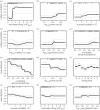Fishing, fast growth and climate variability increase the risk of collapse
- PMID: 26246548
- PMCID: PMC4632620
- DOI: 10.1098/rspb.2015.1053
Fishing, fast growth and climate variability increase the risk of collapse
Abstract
Species around the world have suffered collapses, and a key question is why some populations are more vulnerable than others. Traditional conservation biology and evidence from terrestrial species suggest that slow-growing populations are most at risk, but interactions between climate variability and harvest dynamics may alter or even reverse this pattern. Here, we test this hypothesis globally. We use boosted regression trees to analyse the influences of harvesting, species traits and climate variability on the risk of collapse (decline below a fixed threshold) across 154 marine fish populations around the world. The most important factor explaining collapses was the magnitude of overfishing, while the duration of overfishing best explained long-term depletion. However, fast growth was the next most important risk factor. Fast-growing populations and those in variable environments were especially sensitive to overfishing, and the risk of collapse was more than tripled for fast-growing when compared with slow-growing species that experienced overfishing. We found little evidence that, in the absence of overfishing, climate variability or fast growth rates alone drove population collapse over the last six decades. Expanding efforts to rapidly adjust harvest pressure to account for climate-driven lows in productivity could help to avoid future collapses, particularly among fast-growing species.
Keywords: conservation; coupled social–ecological systems; cumulative impacts; ecosystem-based management; population dynamics.
© 2015 The Author(s).
Figures


 ) of each population. (Online version in colour.)
) of each population. (Online version in colour.)

References
Publication types
MeSH terms
LinkOut - more resources
Full Text Sources
Other Literature Sources
Medical
